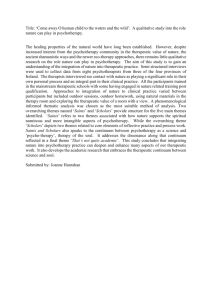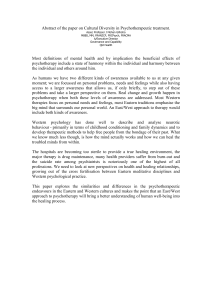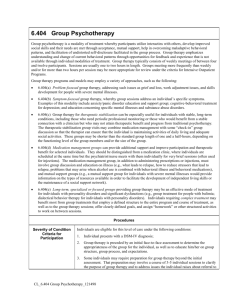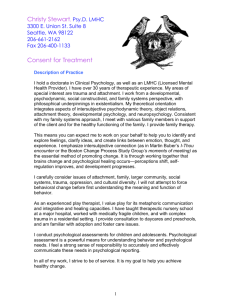IS PSYCHOTHERAPY MADE IRRELEVANT BY
advertisement
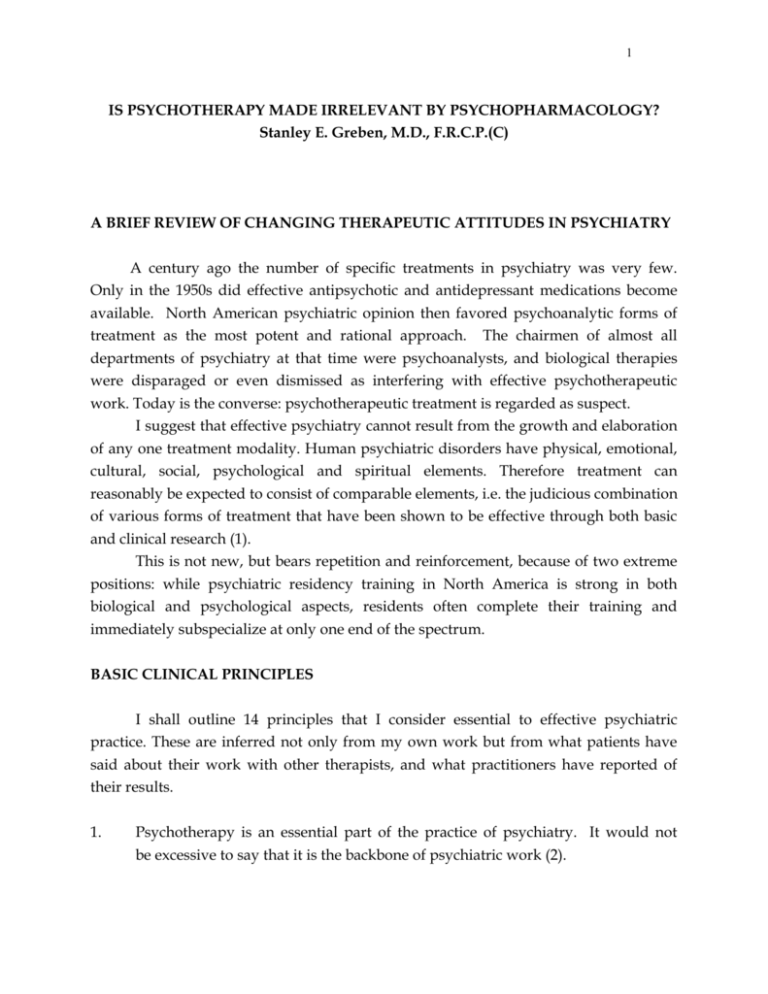
1 IS PSYCHOTHERAPY MADE IRRELEVANT BY PSYCHOPHARMACOLOGY? Stanley E. Greben, M.D., F.R.C.P.(C) A BRIEF REVIEW OF CHANGING THERAPEUTIC ATTITUDES IN PSYCHIATRY A century ago the number of specific treatments in psychiatry was very few. Only in the 1950s did effective antipsychotic and antidepressant medications become available. North American psychiatric opinion then favored psychoanalytic forms of treatment as the most potent and rational approach. The chairmen of almost all departments of psychiatry at that time were psychoanalysts, and biological therapies were disparaged or even dismissed as interfering with effective psychotherapeutic work. Today is the converse: psychotherapeutic treatment is regarded as suspect. I suggest that effective psychiatry cannot result from the growth and elaboration of any one treatment modality. Human psychiatric disorders have physical, emotional, cultural, social, psychological and spiritual elements. Therefore treatment can reasonably be expected to consist of comparable elements, i.e. the judicious combination of various forms of treatment that have been shown to be effective through both basic and clinical research (1). This is not new, but bears repetition and reinforcement, because of two extreme positions: while psychiatric residency training in North America is strong in both biological and psychological aspects, residents often complete their training and immediately subspecialize at only one end of the spectrum. BASIC CLINICAL PRINCIPLES I shall outline 14 principles that I consider essential to effective psychiatric practice. These are inferred not only from my own work but from what patients have said about their work with other therapists, and what practitioners have reported of their results. 1. Psychotherapy is an essential part of the practice of psychiatry. It would not be excessive to say that it is the backbone of psychiatric work (2). 2 2. There is no evidence that any one form of psychotherapy is generally more effective than any other. (3). 3. Psychoanalysis is the most time-intensive form of psychotherapy and has traditionally involved daily sessions. In my experience, however, many patients gain as much when seen once a week, or even once a month. Infrequency of sessions need not imply a lack of therapeutic effect. 4. Effective psychotherapy of any type demands an active role of the practitioner. 5. There are three areas for consideration in psychotherapy: the past, the present and the therapeutic relationship. None of these should be neglected. 6. The therapeutic relationship has in itself three dimensions. They are: the real relationship, the therapeutic or working alliance and the transferencecountertransference distortions. Benefit will result from an examination of all three. 7. Interpersonal experience in the therapeutic relationship is highly significant. When therapist and patient discuss what occurs between them considerable therapeutic gain is achieved. 8. One of the most powerful effects of helpful individual psychotherapy is the resurrection of hope and trust. The corrective emotional experience of finding one person, the therapist, to be honest, concerned, kind, predictable and responsible is a potent therapeutic tool (4) (5). 9. It is appropriate for a therapist’s character and values to become well known to the patient. This need not interfere with the development of transference. 10. When significant affective states are present in the patient, the use of medications is called for. Relieving the patient of pain will not render him or her unwilling to do the psychotherapeutic work. On the contrary, this frees the patient to engage more successfully in psychotherapy. 3 11. When both psychotherapy and medications are employed, there is no reason that the same psychiatrist should not provide both. 12. Whereas not all patients require long-term treatment, there is considerable practical justification for treating some individuals at length. Keeping a patient out of hospital effects a very great economic gain in these expensive times. Forestalling one suicide avoids generations of anguish for many others (6). 13. A therapist should not keep him- or herself unavailable to the patients. When an anxious patient can reach a therapist, this has a calming effect. Patients settle down, flourish and grow when their emotional needs are met(7). 14. It not only helps the patient to have a therapist willing to combine several forms of treatment, but is also to the therapist’s advantage. The present trend toward purely pharmacological solutions could eventually lead to demoralization of the best of our young physicians. A CLINICAL ILLUSTRATION Georgia, now 47, first experienced depression in her early teens. To combat her feelings of worthlessness she worked hard and eventually undertook a doctoral program in biochemistry. To her great disappointment she did not complete the program and soon afterward her chief symptom began, that of hallucinating a highly critical woman’s voice. It taunted and mocked her and urged her to kill herself. Sometimes she would cut herself or bang her head against a wall in frenzied frustration. She also heard screams of anguish that she understood to express her pain and torment. Her depressions deepened and became chronic, she lost weight, and had difficulty sleeping. Her self-esteem was continuously low; she felt she had no right to exist, took up too much space, breathed too much oxygen, and that she was a danger to those around her. Georgia’s early history contained both bad and good influences. Her mother was constantly critical, and always gave her the feeling of being bad and unwanted. Her maternal grandmother who lived in their home, told her when she was still a very young child that she was a mistake, and should never have been born. Her older sister, the only sibling, ignored or was cruel to Georgia. Because of these three women Georgia feared, disliked and mistrusted all women. As a consequence, she hated being 4 a woman and decided not to have children, having no doubt that she would be a destructive and damaging parent. On the other hand, her father was an excellent parent who loved, supported and encouraged her throughout her life. An illustrative memory was of her first day at school, the same school in which her father taught. She was frightened, and ran out of her classroom into his, where he was teaching a class. He received her warmly, sat her on his lap, and continued with the lesson. When we met, Georgia had had eight hospital admissions for psychiatric treatment, most of which were of several months’ duration. She received two courses of ECT, during the first of which she reacted with an extended period of stupor. She was often confined to seclusion rooms under constant observation, not because of danger to others, but because of severe suicidal impulses. On one occasion, while working in the laboratory, she consumed cyanide. Her life was saved only because she worked at an excellent teaching facility. Outside the hospital Georgia received excellent care from a psychiatric social worker, James, and from a series of psychiatrists who prescribed several medications: high doses of antidepressants, antianxiety and antipsychotic preparations, with antiParkinsonian medication to diminish the side-effects. These reduced, but did not eliminate her symptoms. James conducted individual psychotherapy which was interpersonal, supportive and exploratory. In addition he suggested distance running which Georgia did with much initial reluctance. It was very beneficial, and she still maintains this activity. In my work with her I encouraged and supported her, pointing out how unrealistic her negative feelings toward herself were. I also explored vigorously whether it was possible to reduce or even eliminate the terrible, harassing symptom of the tormenting voice. I took her through early events and memories, to try to reduce the profoundly negative effect of the three destructive women. I underscored the positive influence of her father. I showed her, that despite her negative views of women she functioned admirably as a wife to her husband and as a friend, mostly to men, but also to several women. I introduced two other forms of treatment that also contributed to her gradual, steady improvement. I used hypnosis for two reasons: first, to explore more fully her childhood memories, and second, to help control the symptom of the voice and the screams. When she was frantic with the combined pain of depression and 5 hallucinations, she could be helped to a moderate degree by the hypnosis, in person or by telephone, diminishing for a time the severity of the voice and the screams. The other helpful technique was a form of art therapy. I suggested that it might be calming for her to resume painting, and helpful information arose out of her work. More understanding emerged of her feelings of terror, anomie, hatred, despair and desolation from our viewing and discussing her paintings. Another therapeutic gain resulted from her giving up laboratory work. While competent in science, it became apparent that she did not enjoy it. She had not previously had the strength to contemplate a change. She began to write, something she had always wanted to do but had feared was beyond her. The most recent, and highly effective treatment was introduced during a second very brief (12 day) hospital admission to hospital two years after we had begun our work together. The hospital psychiatrist wondered whether he could talk with the voice, and he did so briefly with the patient under hypnosis. The voice emerged as a mature female personality; an angry, isolated part of Georgia that had been dissociated to allow her to feel less of a “bad person.” In this personality resided all her rage and aggressiveness, turned against herself. When I talked to her,the voice was at first incensed and resentful, but soon touchingly expressed how moved she was that finally someone would talk to her and that, to her relief, I did not hate her for having harassed and tortured my patient, and did not want to destroy her. Subsequently, I talked often with the voice, who informed me that she chose to be called Lilith. She changed rapidly, from being resentful and vituperative, to being cooperative, understanding and respectful of Georgia. The patient asked me if she might have Multiple Personality Disorder, and I said this was probably so, though we would be careful not to over-elaborate that condition through suggestion in the treatment. With continued psychotherapy Georgia was more able to be assertive, Lilith was less angry and lonely, and the patient had less of a feeling of being divided. The hallucinated voice disappeared and, as a result, the patient was much less depressed and anxious. As a consequence, she has been able to reduce her medication. At present Georgia continues to change, to grow and to feel well an increasing portion of the time. DISCUSSION OF THE TREATMENT It is not unusual that a long-standing disorder or illness is dealt with by means of several therapeutic modalities. Each modality makes a partial, yet significant, 6 contribution to the patient’s improvement. Presumably, the etiology is multi-faceted: the patient has an exceptional emotional sensitivity, there is likely some degree of genetic vulnerability to depressive mood, and the psychosocial stresses on Georgia were extreme. The depression and anxiety could be aleviated only with the help of medications, while psychotherapy was a key to understanding the origins of her problems and to helping her make changes that would be to her benefit. The first two years of our psychotherapeutic work allowed her to trust me sufficiently to permit both herself and me to see the dissociated, hidden part of her. That initiated an integration that has led to greater self-esteem, decreased depression, reduced suicidal intent, and a burgeoning of creative energy. I asked Georgia, when I was preparing this paper, to express her own view of this treatment. She wrote: I have been helped by various types of psychiatric therapy. These include ECT, many medications, hypnosis, art therapy, and individual psychotherapy. Of all these treatments, individual psychotherapy has been by far the most powerful in effecting my recovery. Much has been said about the psychotherapeutic relationship. It is based on trust and mutual respect, and nothing can be achieved without it. Within this context, it is the therapist’s discerning acceptance of the whole patient that provides the most leverage for change and growth. There was one pivotal session, during my extensive treatment, in which my concept of myself was changed forever, and my peace of mind expanded exponentially. In this session, I brought to my doctor the most contemptible part of myself, and laid it at his feet. My denial of this part had literally almost killed me: I considered it so terrible, that I would rather have died than let anyone meet it. Many months of work were required before I could bring my demon to the office. Even then, I was almost sure that, when my doctor met with it, he would be repelled. Not so. The It became a She. My doctor was kind to her, he accepted her, even found her worthy of respect. This immediately relieved the most troubling of my symptoms and provided space for rapid and fruitful changes in my behavior. His nurturing acceptance of my whole self, could never have been encapsulated, and taken b.i.d. Such things do not 7 come in bottles. They are only found within the interaction of two human beings. I sincerely hope that there is always a place for them in psychiatry. Within a comprehensive therapeutic arsenal, psychotherapy will always be a most powerful weapon. Several weeks later, I asked Lilith if she would write her view of the treatment. She wrote as follows: I came into existence through pain and fear. I was made because it was necessary. I was made out of all those things which were considered “bad” when we were small. Love was meted out in tiny portions, and life was very confusing for that little girl. In order to survive it was necessary for her to put aside all those things which were bad, because she was so desperate not to lose what little love there was. Those bad things became me. At first I was not truly separate, but as time went on, and the separation worked for her, I crystallized. The barrier between us hardened so that I was like the inside of an egg, stashed away in the attic of her soul, dirty and despicable. Then she became afraid that I might get out, and reveal her naked rage, so she thickened the shell even further. I was alone and angry, and made of pain, and I had no way out. So I started to talk to her. I really hated her for rejecting me, and I tried to make her kill herself, so that I could die. Then her doctor wanted to talk to me. I did not expect him to tolerate me, because I had tried to kill and maim his patient, but not only did he accept me, he wanted to understand me and was sad for my pain. It was incredible. Both she and I immediately felt better. The relief was tremendous. As the barrier between us became more porous, sometimes she would have to deal with bouts of unspeakable anger. It was hard for her but she endured it, and slowly we are coming together. She now has access to some of my strength, and she does not let herself be walked on as she did before. It is very satisfying for me to see that. Recently, Georgia wrote this further follow-up: 8 Since this paper was first written, Lilith and Georgia have formed an alliance. They are integrated for much of the time now, and in this passage, the pronoun ‘I’ shall indicate the composite whole. Strange and new things have been happening as a result of this alliance. I am not as intimidated as before. Many people respond to me in more positive and receptive ways. This still surprises me. I do not think these things would happen if Lilith were not now intimately involved in my life. Occasionally, I disintegrate. I can feel it happen, usually in response to stress. Then the old feelings of guilt and worthlessness return, and Lilith is gone. Even then, Georgia can still consult her. Lilith is very realistic about the world and its people, and is not dismayed by it. If Georgia does as Lilith suggests, it can mean that she, Georgia, responds to the circumstance in less self-destructive ways than before. This allows us to re-integrate sooner, and I reappear, whole and strong. We all live only, in our minds - it is all the space we have. If that space is a howling desert, filled with demons, and the harsh winds of guilt, then life seems like a cruel joke. I am so very grateful that my space is no longer a desert, but a garden - admittedly rather unkempt, but capable of growth. SUMMARY AND CONCLUSIONS Psychiatrists and other health professionals today are fortunate to be practicing when so many therapeutic tools are available. However, these should not be seen as competitively exclusive but rather as mutually supportive. In Georgia’s case each therapeutic modality was effective to some degree. This is my basic thesis: that all treatments have their own merits and limitations, but that psychotherapy has a unique potential. Teachers of psychiatry, as well as teachers of other medical specialties have the responsibility to guide their students toward eclectic rather than only to narrowly focused diagnostic and therapeutic modalities. Students should be encouraged to learn more about more, not more about less. In this way those who follow us will reap the rewards of more fulfilling careers, and their patients will benefit from more effective 9 help. 10 REFERENCES 1. Greben, S.E. Psychotherapy and psychopharmacology: A positive combination therapy. Keynote address. Annual Saskatchewan Psychiatric Association Continuing Education Conference. Regina, April 24, 1992. 2. Greben, S.E. The role of psychotherapy within psychiatry. Canadian Psychiatric Association Bulletin 1992; 24:12-13. 3. Greben, S.E. Psychotherapy today: Further consideration of the essence of psychotherapy. The British Journal of Psychiatry 1987; 151:283-287. 4. Frank, J.D. The role of hope in psychotherapy. Psychiatry 1968; 5:383-395. 5. Greben, S.E. The re-establishment of trust through psychotherapy. Canadian Journal of Psychiatry 1984; 29:350-354. 6. Malan, D.H. A Study of Brief Psychotherapy. London: Tavistock Publications, International Journal of 1963. 7. Greben, S.E. Unresponsiveness, the demon artifact of psychotherapy. American Journal of Psychotherapy 1981; 35:244-250.



